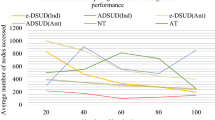Abstract
“Black hole” are widely spread in the mobile communication data, which will highly downgrade the mobile service quality. OLAP tools are extensively used for the decision-support application in the multidimensional data model, which just like the mobile communication case. As different dimensions of the mobile data are incomparable and, thus, can hardly generate one unique final value that satisfies all dimensions. We exploit the skyline operator as the postoperation while building data cubes, named as data cube of skyline. As the skyline of a cuboid is not derivable from another cuboid and the skyline operation is holistic, which makes this problem even challeging. In this paper, we propose a method in materializing the cube of skyline in the big communication data and proof its effectiveness and efficiency by extensive experiments.
Access this chapter
Tax calculation will be finalised at checkout
Purchases are for personal use only
Similar content being viewed by others
Notes
- 1.
For example, it’s meaningless to compare “year” dimension to “region” dimension.
References
Borzsony, S., Kossmann, D., Stocker, K.: The skyline operator. In: ICDE 2001, pp. 421–430 (2001)
Gray, J., Chaudhuri, S., Bosworth, A., et al.: Data cube: a relational aggregation operator generalizing group-by, cross-tab, and sub-totals. In ICDE’96, pp. 152–159
Dehne, F., Eavis, T., Hambrusch, S., Rau-Chaplin, A.: Parallelizing the data cube. Distrib. Parallel Databases 11(2), 181–201 (2002)
Dehne, F., Eavis, T., Rau-Chaplin, A.: A cluster architecture for parallel data warehousing. In: ISCC’01, pp. 161–168
Goil, S., Choudhary, A.: A parallel scalable infrastructure for OLAP and data mining. In: IDEAS’99, pp. 178–186
Chen, Y., Dehne, F., Eavis, T., Rau-Chaplin, A.: Parallel ROLAP data cube construction on shared-nothing multiprocessors. In: IPDPS’03, pp. 10–18
Tan, K.-L., Eng, P.-K., Ooi, B.C.: Efficient progressive skyline computation. In: VLDB, vol. 1, pp. 301–310 (2001)
Kossmann, D., Ramsak, F., Rost, S.: Shooting stars in the sky: an online algorithm for skyline queries. In: PVLDB’02, pp. 275–286
Papadias, D., Tao, Y., Greg, F., Seeger, B.: Progressive skyline computation in database systems. TODS 1, 41–82 (2005)
Bartolini, I., Ciaccia, P., Patella, M.: Efficient sort-based skyline evaluation. TODS 33(4) (2008). 31
Borzsony, S., Kossmann, D., Stocker, K.: The skyline operator. In: ICDE’01, pp. 421-430
Chomicki, J., Godfrey, P., Gryz, J., Liang, D.: Skyline with presorting. In: ICDE, vol. 3, pp. 717–719 (2003)
Godfrey, P., Shipley, R., Gryz, J.: Algorithms and analyses for maximal vector computation. VLDBJ 16(1), 5–28 (2007)
Zhang, S., Mamoulis, N., Cheung, D.W.: Scalable skyline computation using object-based space partitioning. In: SIGMOD’09, pp. 483–494
Pei, J., Jin, W., Ester, M., Tao, Y.: Catching the best views of skyline: a semantic approach based on decisive subspaces. In: PVLDB, pp. 253–264
Pei, J., Yuan, Y., Lin, X., Jin, W., Ester, M., Liu, Q., Wang, W., Tao, Y., Yu, J.X., Zhang, Q.: Towards multidimensional subspace skyline analysis. TODS 31(4), 1335–1381 (2006)
Yuan, Y., Lin, X., Liu, Q., Wang, W., Yu, J.X., Zhang, Q.: Efficient computation of the skyline cube. In: PVLDB’05, pp. 241–252
Zhao, Y., Deshpande, P., Naughton, J.F.: An array-based algorithm for simultaneous multidimensional aggregate. In: SIGMOD’97
Beyer, K., Ramakrishnan, R.: Bottom-up computation of sparse and iceberg cubes. In: SIGMOD’99
Han, J., Pei, J., Dong, G., Wang, K.: Efficient computation of iceberg cubes with complex measures. In: SIGMOD’01, pp. 1–12
Acknowledgement
This work was supported by Natural Science Foundation of China (No. 61170003).
Author information
Authors and Affiliations
Corresponding author
Editor information
Editors and Affiliations
Rights and permissions
Copyright information
© 2017 Springer International Publishing AG
About this paper
Cite this paper
Zhang, J., Hong, S., Lin, Y., Mou, Y., Li, H. (2017). Finding the Typical Communication Black Hole in Big Data Environment. In: Tan, Y., Takagi, H., Shi, Y. (eds) Data Mining and Big Data. DMBD 2017. Lecture Notes in Computer Science(), vol 10387. Springer, Cham. https://doi.org/10.1007/978-3-319-61845-6_26
Download citation
DOI: https://doi.org/10.1007/978-3-319-61845-6_26
Published:
Publisher Name: Springer, Cham
Print ISBN: 978-3-319-61844-9
Online ISBN: 978-3-319-61845-6
eBook Packages: Computer ScienceComputer Science (R0)




